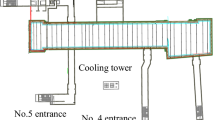Abstract
In order to study the deformation law of adjacent building structures, surface settlement, displacement of supporting piles, axial force and variation of water level during different excavation stages of deep excavation construction, the deep foundation pit project in the M1 line of the Jinan Metro was used as the background, and the data from field measurement of excavation and support were analyzed. The results show that the horizontal displacement of the pile presented a pronounced “bow” shape with the excavation of the foundation pit. The maximum horizontal displacement of the pile appeared at one third of the top of the pile, with a maximum of 31.98 mm. The maximum value of monitored axial force was 3100 kN, which was much less than the control value of 6847 kN. The maximum axial force appeared on the second steel support. The axial force of the first reinforced concrete support rapidly increased with the time. It was considered that the initial bearing capacity of the concrete was low, so the axial force of the concrete support was smaller than the steel support. The strength and load-bearing capacity of concrete increased in the later period, which resulted in a rapid increase in axial force. At the same time, during the process of setting up or dismantling the support, the attention should be paid to the axial force change of the adjacent support to prevent the danger caused by the abrupt change of the axial force. The maximum settlement value of the building appeared at the two corners far from the foundation pit, with the value of 4.3 mm. When the constructions were 34 m away from the deep foundation pit, the impact of dewatering on the building was greater than that of the foundation pit excavation, and he effect of the dewatering on the variational soil texture in this area was different. The maximum angular variation of adjacent constructions was 1/16,050, which was less than the 1/5000 of the minimum angular variation. The foundation pit structure and building were in a safe state, and the layout of the supporting structure was reasonable.











Similar content being viewed by others
References
Borja RI (1990) Analysis of incremental excavation based on critical state theory. J Geotech Eng Div 116(6):964–985
He C, Liu XZ (2014) Case analysis of a large settlement caused by safe excavation of a deep foundation pit near a building. J Rock Eng 36(S2):479–482 (in Chinese)
He W, Pan XY, Zhang J et al (2013) Monitoring and environmental impact analysis of deep excavation of subway stations in river islands. Chin J Geotech Eng 35(S1):478–483 (in Chinese)
Li L, Duan BF (2013) Monitoring measurement and numerical simulation for deep foundation pit of subway station. Chin J Rock Mech Eng 32(S1):2684–2691 (in Chinese)
Li ZW, Zheng G (2013) Three-dimensional finite element analysis of the influence of excavation on adjacent buildings with different stiffnesses. Rock Soil Mech 34(1):1807–1814 (in Chinese)
Li S, Zhang DL, Fang Q et al (2012) Surface deformation characteristics of deep foundation pit in Beijing metro station. Chin J Rock Mech Eng 31(1):189–198 (in Chinese)
Liu FZ, Xie XY (2014) Analysis of the effect of groove formation of subway foundation pit retaining structure on the settlement of adjacent buildings and monitoring data. Chin J Rock Mechan Eng 33(S1):2901–2907 (in Chinese)
Liu J, Yao HL, Ren JX (2010) Deformation monitoring and numerical simulation of the foundation pit retaining structure in metro stations. Rock Soil Mech 33(S2):456–461 (in Chinese)
Ma XF, Zhang HH, Zhu WJ (2008) Centrifugal model test study on the influence of deep excavation on high-rise buildings nearby. Chin J Geotech Eng 30(1):499–504 (in Chinese)
Potts DM, Fourite AB (1984) The behavior of a popped retaining wall, result of a numerical experiment. Geo-technique 34(3):383–404
Wang WD, Xu ZH (2010) Simplified analysis method for evaluating excavation-induced damage of adjacent buildings. Chin J Geotech Eng 32(1):32–38 (in Chinese)
Xu CJ, Jin Y, Sun FM (2013) Study on joint influence of pile foundation construction and excavation on adjacent buildings. Chin J Geotech Eng 35(2):809–813 (in Chinese)
Zhao XS, Ai CG, Wang X et al (2014) Numerical analysis of deformation monitoring of excavation and support of deep foundation pit in sandy soil. J Henan Univ Sci Technol Nat Science Ed 35(6):61–66 (in Chinese)
Zheng G, Li ZW (2012) Finite element analysis of the influence of foundation pit excavation on buildings at neighboring arbitrary angles. Chin J Geotech Eng 34(1):615–624 (in Chinese)
Acknowledgements
This work was supported by the National Natural Science Foundation of China (No. 51009015) and Liaoning province natural science foundation of China (No. 20170540143).
Author information
Authors and Affiliations
Corresponding author
Rights and permissions
About this article
Cite this article
Wang, Z., Wang, C. Analysis of Deep Foundation Pit Construction Monitoring in a Metro Station in Jinan City. Geotech Geol Eng 37, 813–822 (2019). https://doi.org/10.1007/s10706-018-0651-3
Received:
Accepted:
Published:
Issue Date:
DOI: https://doi.org/10.1007/s10706-018-0651-3




